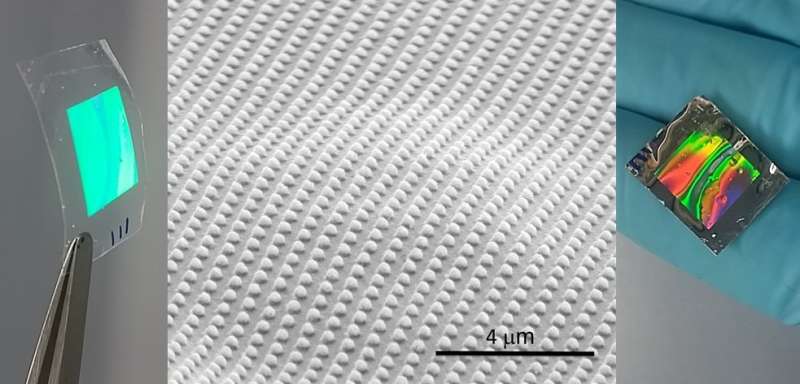Iridescent photonic cellulose, mimicking the structural color of insects, with optical applications

The bright colors of some butterflies, beetles or birds are not due to the presence of pigments that selectively absorb light, but due to the so-called structural coloration. Structural coloration occurs on surfaces with a nanostructure with dimensions similar to those of the wavelength of the incident light (typically below the micron). These ordered nanostructures are known as photonic crystals. There is a great interest in providing cellulose, the most abundant polymer in earth, biocompatible and biogradable, with these structures, which can offer new optical and electric functionalities.
The study published today in Nature Photonics, led by Dr. Agustín Mihi of the Institute of Materials Science of Barcelona (ICMAB-CSIC), creates for the first time photonic crystals and plasmonic structures of a cellulose derivative through its nanostructuring with the soft lithography technique. By periodically nanostructuring the cellulose film, it is no longer transparent and begins to reflect intense colors, depending on the pattern with which it has been molded.
With this new, fully scalable and low cost technique, alternative to the traditional self-assembly of cellulose nanocrystals, a high quality and reproducible nanostructure is created on this polymer in a very short time, and achieving a wide range of iridescent colors, only depending on the size and morphology of the created structures.
These photonic crystals can be nanoimprinted on different substrates to provide photonic properties on surfaces that do not present this property, such as paper, demonstrating the potential of this technology as photonic ink, for applications in anti-counterfeiting technology, packaging, decorative paper, labels or sensors, among others.
When these structures are covered with a thin metal layer, they acquire plasmonic properties while maintaining their flexibility, achieving brighter colors. Furthermore, depending on the type of cellulose derivative used, its degree of biodegradability and solubility in water can be tuned. These plasmonic structures can be used as disposable sensors for Raman emission or to increase the light emitted by a dye.
More information: Hydroxypropyl cellulose photonic architectures by soft nanoimprinting lithography. Nature Photonics. DOI: 10.1038/s41566-018-0152-1
Journal information: Nature Photonics
Provided by ICMAB



















